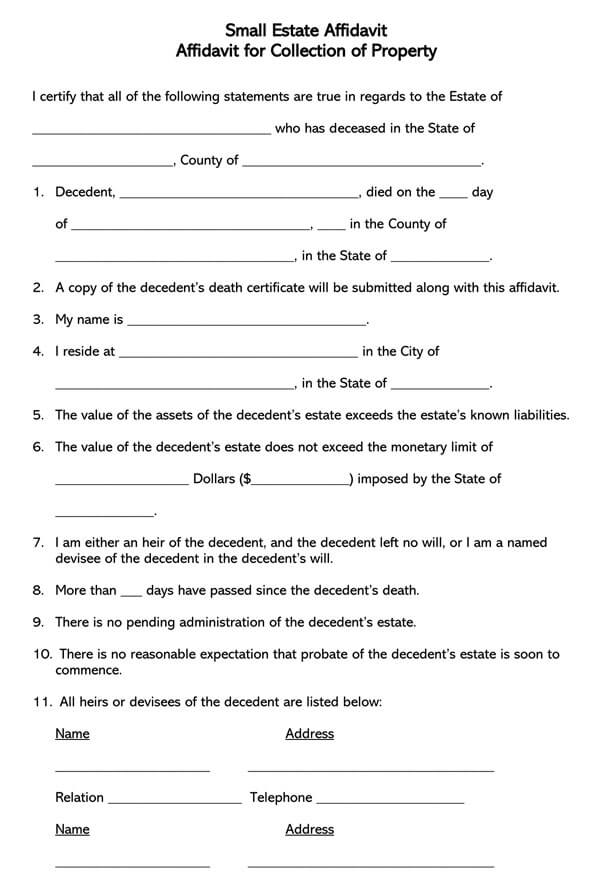A small estate affidavit is a document used by individuals who feel rightfully entitled to legally claim inheritance (assets or property) after the passing away of a family member or friend.
It is often used when the decedent did not leave a will behind, but this will depend on applicable state laws. An estate is only deemed “small” if the inheritance in question is valued within certain limits, which vary from state to state. This affidavit is typically used by individuals with a net worth ranging between $5000 and $150000 – the maximum permissible net worth is state-specific, so it is important first to consult estate laws applicable in one’s state.
The petitioner or claimant presents the affidavit to a Probate Court in their county or jurisdiction. Upon submission, they should notify all creditors as they are entitled to payment before any decedent’s outstanding debts are settled.
A small estate affidavit is also referred to as an Affidavit for Collection of Personal Property.
Small Estate Affidavit Introduction
Also referred to as an Affidavit for Collection of Personal Property, this is a legal document that one would use to have the property transferred to them without having to go through the expense of a probate process. It is used to grant authority to someone, such as a beneficiary or will executor, to take responsibility or transfer the responsibility of the deceased’s possessions and property. This would include possessions, such as jewelry, bank accounts, vehicles, and artwork that were owned by the deceased.
The user of the affidavit then has it within their remit to determine how the deceased’s assets will be managed or distributed to any beneficiaries. It also makes that person responsible for paying off debts that the dead may still have.
Free Forms
Following are free templates to be customised as per need:
By states
Standard template

Purpose
A small estate affidavit is used to legally transfer and pass on the obligation of properties from a decedent to their beneficiary or executor of the will. It is majorly used to avoid the lengthy probate process when acquiring an inheritance. Through the document, beneficiaries of a decedent’s estate can approach any person, company, or bank that currently holds estate property formerly owned by the decedent to request them to hand over the assets. Properties transferrable under a small estate affidavit include bank accounts, art, vehicles, jewellery, etc.
Through the affidavit, the claimant acquires the power to manage and distribute the decedent’s estate, including settlement of debts. No entity is expected to decline the transfer of any property belonging to the estate. The entities are expected to transfer the assets as stipulated by the terms of the affidavit or otherwise face legal prosecution.
The transfer of property through a such affidavit is primarily used when the departed property owner did not leave a last will and testament behind and has assets valued below $5000 to $175000 (depending on the state of residence) to be inherited by his or her beneficiaries.
Small Estate Vs. Affidavit of Heirship
A small estate and affidavit of heirship are both documents that can be used by people seeking legal possession of their predecessor’s property without having to go through the long and tasking probate process.
An affidavit of heirship is primarily used to identify or authenticate the heirs/beneficiaries of a decedent’s estate. Additionally, it can be attached to a small estate affidavit or submit to transfer ownership of a decedent’s real estate (any buildings or land) to their beneficiary. It is filed with the county office responsible for land records (deeds) to transfer real property. The affidavit of heirship is used for distributing real property because, more often than not, the value of this property will exceed the maximum legal amount permitted by the state.
A small estate affidavit, as earlier mentioned, is used to transfer all types of property (accurate and personal) whose valuation is within the state-recommended thresholds for the beneficiary to bypass the probate process. It also accommodates property of sentimental value to the claimant.
Understanding Small Estate Affidavit
To maximally utilise the applications of this affidavit, it is essential to have an extensive understanding of the document. This includes under what conditions one can use it. Below are some of the distinctive factors to consider before using such an affidavit:
Small estate affidavit limits
All states in the US have a limit on the total value of property and assets that can be distributed using this affidavit. Assets and property above or below the set limits cannot be claimed through the affidavit. Laws governing this across states are as follows.
| State | Non-transferable property and Assets | Maximum Allowance (limit) |
| Alabama | Real property | $29,710 (for 2019) |
| Alaska | Real property | $100,000 (motor vehicles); $50,000 (personal property) |
| Arizona | – | $100,000 (real property); $75,000 (personal property) |
| Arkansas | – | $100,000 |
| California | Real property | $166,250 |
| Colorado | Real property | $69,000 (if the decedent died in 2019) |
| Connecticut | Real property | $40,000 |
| Delaware | Real property | $30,000 |
| District of Columbia | – | $40,000 |
| Florida | – | Typically, $75,000, but varies by county |
| Georgia | – | $10,000 (of cash given by a financial institution) |
| Hawaii | Motor vehicles | $100,000 |
| Idaho | Real property and motor vehicles | $100,000 |
| Illinois | – | $100,000 |
| Indiana | Real property | $50,000 |
| Iowa | Real property | $100,000 |
| Kansas | Real property | $40,000 |
| Kentucky | – | $15,000 |
| Louisiana | – | $125,000 |
| Maine | Real property | $40,000 |
| Maryland | – | $50,000$100,000 if the spouse is the ONLY person to inherit the estate |
| Massachusetts | Real property | $25,000 |
| Michigan | Real property | $15,000 |
| Minnesota | Real property | $75,000 |
| Mississippi | – | $50,000 |
| Missouri | – | $40,000 |
| Montana | Real property | $50,000 |
| Nebraska | Motor vehicles | $50,000 |
| Nevada | Real property | $25,000$100,000 if the spouse is the ONLY person to inherit the estate |
| New Hampshire | – | $10,000 |
| New Jersey | Real property | $20,000$50,000 if spouse/partner in a civil union/domestic partner is the ONLY person to inherit the estate |
| New Mexico | Real property | $50,000 |
| New York | Real property | $30,000 |
| North Carolina | – | $20,000$30,000 if the spouse is the ONLY person to inherit the estate |
| North Dakota | Real property | $50,000 |
| Ohio | – | $35,000$100,000 if the spouse is the ONLY person to inherit the estate |
| Oklahoma | Motor vehicles | $50,000 |
| Oregon | – | $200,000 (real property)$75,000 (personal property) |
| Pennsylvania | Real property | $50,000 |
| Rhode Island | Real property | $15,000 |
| South Carolina | Real property | $25,000 |
| South Dakota | – | $50,000 |
| Tennessee | Real property | $50,000 |
| Texas | Real property | $75,000 |
| Utah | – | $100,000 |
| Vermont | – | $10,000 |
| Virginia | – | $50,000 |
| Washington | – | $100,000 |
| West Virginia | Real property | $100,000 |
| Wisconsin | – | $50,000 |
| Wyoming | – | $200,000 |
Probate introduction
Probate is a legal process undertaken when a person (decedent) dies. Probate usually aims to prove that the decedent’s will is valid in court, identify, inventory, and appraise the decedent’s assets. After which any debts and taxes owed by the decedent are paid from his assets, and the remaining assets are distributed to his or her beneficiaries as per his or her will (if any) or state law (if there is no will). It is typically a long procedural, expensive, and time-consuming process. Any expenses incurred during the probate process are deducted from the decedent’s assets and, as a result, reduces the amount of what is available for inheriting.
Having an adequate understanding of the probate process and its application to small estates comes in handy when seeking inheritance transfer. We shall look into various aspects of the process.
As earlier mentioned in the article, a decedent’s property and assets must not exceed particular set margins that are state-specific. This means what is meant by “small estate” will depend on the jurisdiction. As a result, each state has its own procedures to streamline the probate process within its borders. This means claimants can use less time, money, and court involvement.
Individuals or organisations require the small estate affidavit to be presented before they can transfer ownership of the decedent’s property on the condition that it is signed, notarized, and approved by a local probate court.
Making a Small Estate Affidavit
Once an individual (petitioner) has familiarised themselves with applicable state laws, they should develop an affidavit that complies with them. We shall look into how to write a small estate affidavit by outlining the steps necessary below and what to include other than the names and addresses of the concerned parties:
Outline the date of death of the decedent
The initial step is to ascertain the date of death. This should be by the backing of a medical practitioner or official records. The city where the death occurred, as well as the state, should be declared. All this information can be obtained from the decedent’s death certificate.
Wait the minimum period
Every state declares that claimants can only file the small estate affidavit after a specified number of days after the decedent’s death. This limit is usually between 15-60 days, and it should be indicated on the affidavit. One should use this period to gather information about the decedent’s assets and property and develop an itemised list of the same.
Declare if it is Intestate or testate death
Next, one should determine if the decedent left a will or not and indicate it on the document. This is important because some states dictate that a will must be presented for a small estate affidavit to be used; others do not require one, while others allow both scenarios. If a will is available, the one filing the affidavit must have a copy of it – this can be a beneficiary or whoever was named the executor of the will.
Outline and describe outstanding funeral expenses
Since filing a small estate affidavit will ordinarily take place after the burial of the departed, it should first be confirmed if there are pending bills due to funeral expenses. These expenses should be listed, described in detail, and paid in full.
Indicate additional claims
If the decedent had any outstanding debts, their estate should pay those debts, and creditors paid accordingly if all the assets in the estate can cover these debts entirely. These debts should be clearly defined. The remaining assets are the ones to be distributed to the heirs mentioned in the affidavit.
List the surviving heirs
A list of every surviving heir who has legal claims to the decedent’s property should be provided in the affidavit. They usually are spouses and close relatives.
Identify personal property
The next step is to identify the decedent’s personal property. This includes motor vehicles, general possessions like clothing and jewelry, and any other item that is not real property. A description of this property and its total value should be given in the affidavit.
Declare real property
After the personal property has been identified, the real property should be declared. A proper description and total monetary value of the property should be outlined. Real property includes houses, land, business, etc. however, it should be noted that not all states allow the transfer of real property through a small estate affidavit.
The decedent’s net worth depends on the personal and real property owned and will affect the amount to be received by every heir.
Gather all the relevant documents
A small estate affidavit must be accompanied by other documents to be executed. The claimant must obtain them as required. These documents include a death certificate (which can be obtained from the county office or Bureau of Vital Statistics), title for property (land and vehicles) owned by the departed. These documents must be attached to the affidavit.
Contact the family members
After the document is completed, all heirs, family members, or people that could be entitled to the assets should be made aware of the existence of this affidavit. Contact must be made via Certified Mail with a return receipt so that receipts can be kept as proof that the individuals were notified.
File the document with the Probate Court Clerk’s office
Once the small estate affidavit has been signed and notarized, the petitioner can present the document to the local probate court clerk’s office, usually at a fee. The clerk should ordinarily take 5-15 days to process the filing and accept or reject it. If accepted, ownership of the assets can now be duly be transferred.
Small Estate Affidavit State Laws
As earlier mentioned, state laws will significantly influence how and when these affidavits can be used to claim property and assets of a deceased. Below are laws that are applicable within different states:
| State | Maximum Amounts ($) | Time to Wait After Decedent’s Death | Laws |
| Alabama | $25,000 | 30 days | § 43-2-692 |
| Alaska | $100,000 for vehicles, $50,000 for non-vehicles | 30 days | § 13-16-680 |
| Arizona | $75,000 | 30 days | § 14-3971 |
| Arkansas | $100,000 | 45 days | § 28-42-101 |
| California | $166,250 | 40 days | PROB § 13100 |
| Colorado | $70,000 | 10 days | § 15-12-201 |
| Connecticut | $40,000 | No Statute | Sec. 45a-273 |
| Delaware | $30,000 | 30 days | § 2306 |
| Florida | $75,000 | No Statute | Chapter 735 |
| Georgia | $10,000 | No Statute | § 7-1-239 |
| Hawaii | $100,000 | No Statute | § 560:3-1201 |
| Idaho | $100,000 | 30 days | § 15-3-1201 |
| Illinois | $100,000 | No Statute | 755 ILCS 5/9-8 |
| Indiana | $50,000 | 45 days | § 29-1-8-1 |
| Iowa | $200,000 | No Statute | § 635.1 to § 635.13 |
| Kansas | $40,000 | No Statute | § 59-1507b |
| Kentucky | $30,000 | No Statute | § 391.030 & § 395.455 |
| Louisiana | $125,000 | No Statute | CCP 3421 |
| Maine | $40,000 | 30 days | § 3-1201 |
| Maryland | $100,000 for spouse, $50,000 for descendants | No Statute | § 5–601 |
| Massachusetts | $25,000 | 30 days | § 3-1201 |
| Michigan | $15,000, as adjusted by § 700.1210 | 28 days | § 700.3982 |
| Minnesota | $75,000 | 30 days | § 524.3-1201 |
| Mississippi | $75,000 | 30 days | § 91-7-322 |
| Missouri | $40,000 | 30 days | § 473.097 |
| Montana | $50,000 | 30 days | § 72-3-1101 |
| Nebraska | $50,000 | 30 days | § 30-24,129 |
| Nevada | $100,000 for spouse, $25,000 for other claimants | 40 days | NRS 146.080 |
| New Hampshire | No Statutes | No Statutes | § 553:32 |
| New Jersey | $50,000 for spouse, $25,000 for heirs | No Statute | § 3B:10-3 to 3B:10-4 |
| New Mexico | $50,000 | 30 days | § 45-3-1201 |
| New York | $30,000 | No Statute | § 1301 to § 1312 |
| North Carolina | $20,000 | 30 days | § 28A-25-1 |
| North Dakota | $50,000 | 30 days | Chapter 30.1-23 |
| Ohio | $100,000 for spouse, $35,000 for other claimants | No Statute | R.C. 2113.03 |
| Oklahoma | $50,000 | 10 days | 58 OS § 393 |
| Oregon | $275,000 ($75,000 for personal property, $200,000 for real property) | 30 days | § 114.515 |
| Pennsylvania | $50,000 | 60 days | 20 § 3102 |
| Rhode Island | $15,000 | 30 days | § 33-24-1 |
| South Carolina | $25,000 | 30 days | § 62-3-1201 |
| South Dakota | $50,000 | 30 days | § 29A-3-1201 |
| Tennessee | $50,000 | 45 days | § GN 02315.081 |
| Texas | $75,000 | 30 days | Sec. 205.001 |
| Utah | $100,000 | 30 days | § 75-3-1201 |
| Vermont | $45,000 | No Statute | 14 V.S.A. § 1902 |
| Virginia | $50,000 | 60 days | § 64.2-601 to § 64.2-605 |
| Washington | $100,000 | 40 days | § 11.62.010 |
| West Virginia | $100,000 | No Statute | § 44-3A-5 |
| Wisconsin | $50,000 | No Statute | § 867.03 |
| Wyoming | $200,000 | 30 days | § 2-1-201 |
Frequently Asked Questions
The cost will vary from one attorney to the other. However, on average, it is usually between $200 and $400.
This depends on how complicated the situation is. While you can fill out and submit the Small Estate Affidavit Form yourself, it can be beneficial to have legal advice in case any issues come up.
It can generally take between 5 to 15 days, depending on the complexity of the estate assets.
No. Every state in the United States (US) has its definition of a small estate. The limits (maximum and minimum) of the value of assets and property subjected to small estate affidavits are provided under state laws.
A signed, notarized, and probate court-approved affidavit is presented to the person or organisation currently holding the ownership of the deceased’s assets and property. Once verified, the transfer is made.








